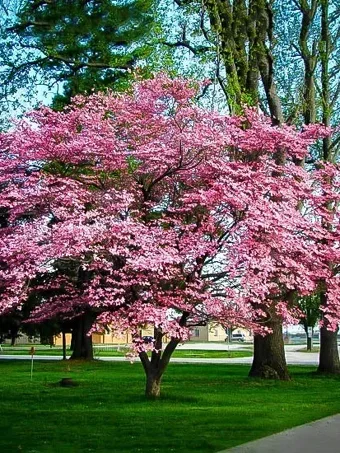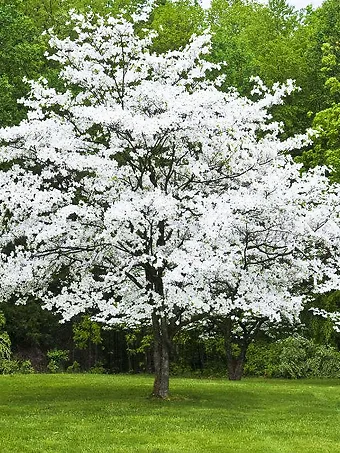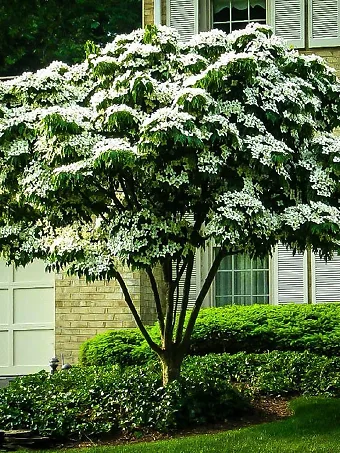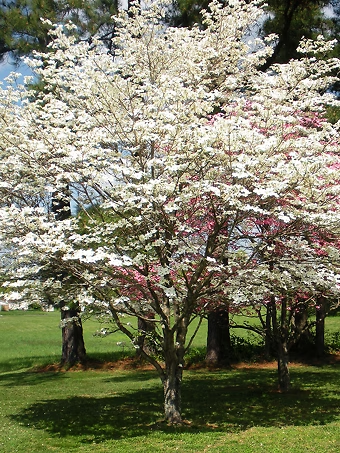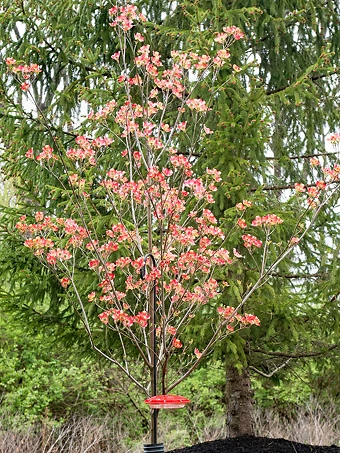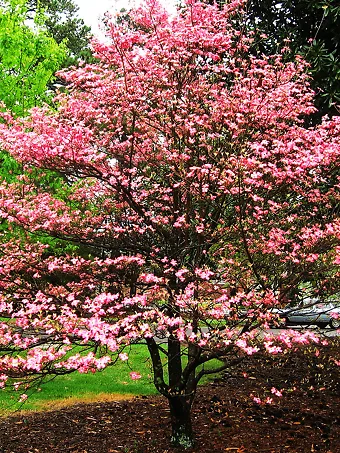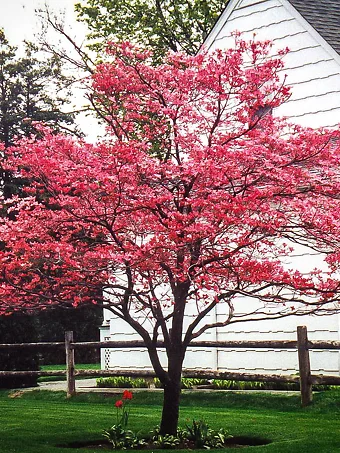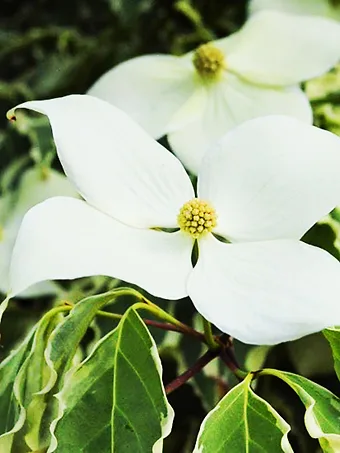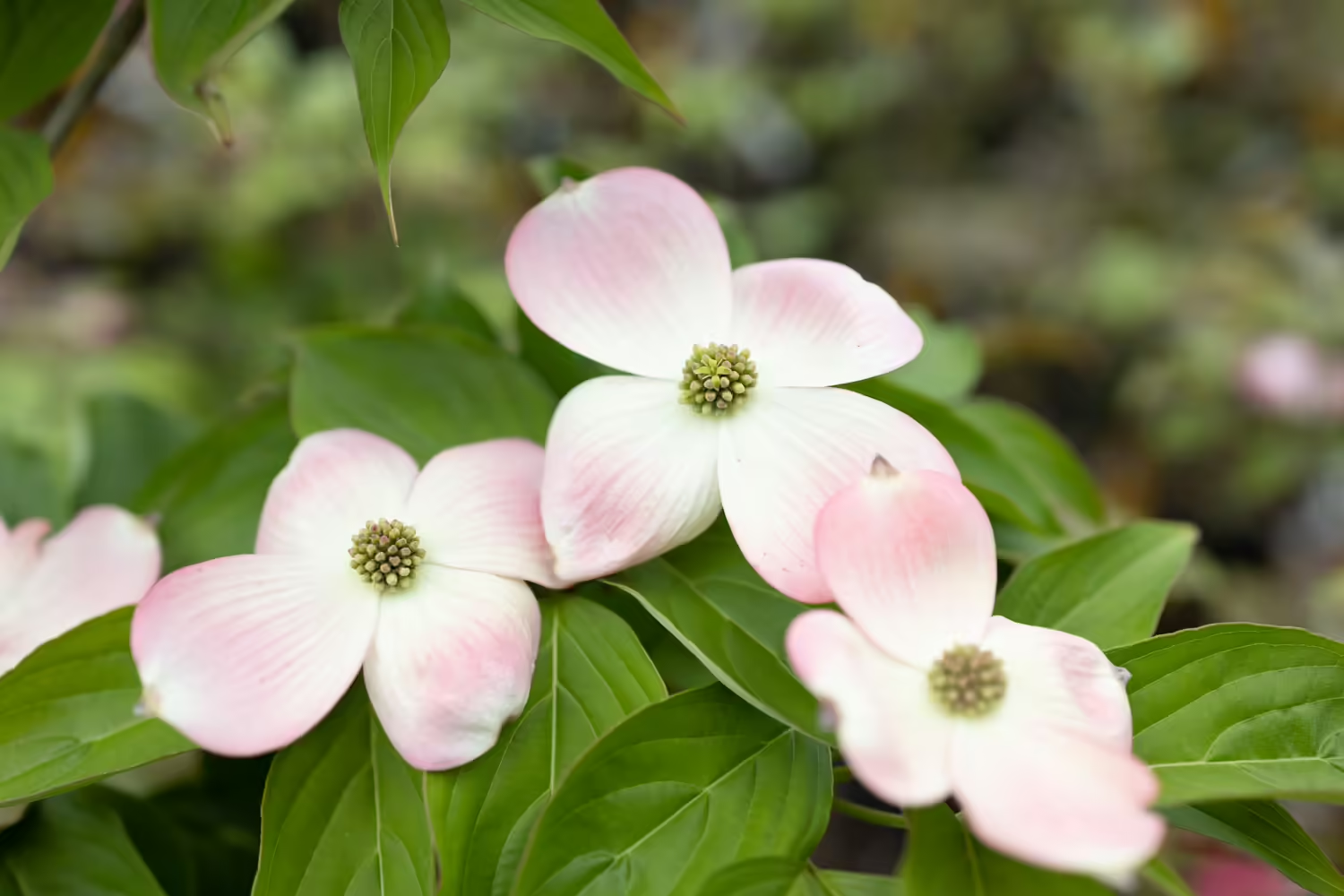
Written by s • How to Choose a Flowering Dogwood Tree
Flowering Dogwood Trees are among the most spectacular flowering trees there are, and they are top choices for any garden. Grown as a lawn specimen, planted as background trees for your garden, or grown along the fringes of wooded areas, their spring and early summer blooming is a fantastic seasonal highlight, and lasts for several weeks. Some have attractive fruit, with amazing fall colors too, and their graceful branching makes them beautiful in summer, when they are clothed in green.
In some parts of the country local wild populations have been devastated by disease, which has spread to garden trees too, so its understandable that you might be uncertain of how to get the best out of these great plants. Let’s try to help, with a guide to what to look for when choosing a dogwood tree for your own garden.
Choose the Color
The classic ‘flowers’ of the dogwood tree are white, but there are other choices too. In this tree the true flowers are not showy – it is modified leaves called bracts that make the large, spreading ‘petals’ of the blooms. Besides the delicious creamy white that sets the standard for them, breeding and selection have given us a whole range of colors from pale pink to near-red, so consider choosing a colorful variety. If you have the space in your garden, then a mix of colors will create an unbeatable display. The American dogwood is available in lots of colors, and so are the hybrid trees. Asian dogwoods are mostly white, and the pinks and reds that do exist can fade as the flowers age, so for strong color choosing an American or hybrid tree is usually best.
Choose the Size
Most flowering dogwood trees develop into broad, spreading plants with layered branching. With either a single short trunk, or several main stems of equal sizes, mature trees are usually at least as broad as they are tall, and often wider. Most trees fall in the range of 15 to 30 feet tall and wide, so when choosing a planting spot, be sure to allow enough room for that mature spread. Not providing enough room for trees is the most common mistake seen in new gardens, so use a tape to check if you have given your new tree the space it needs.
If a full-sized tree is more than your garden can handle, don’t despair, as many of the newer, hybrid trees are significantly smaller, and trees in the 12 to 18-foot range are readily available. Take a look at the space you have, so that when browsing for a tree you can look at the sizes and choose something that will fit.
Choose the Flowering Time
The fact that there are three or four possible types of dogwood you can grow, with different characteristics and different flowering times, causes some confusion, but it’s worth understanding. By choosing appropriately you can enjoy almost 3 months of dogwoods blooming in your garden. The American native dogwood, which is often the most common in gardens as well, is Cornus florida. This is also the first to flower, usually in April, doing it on bare branches. Flowers last for about 3 weeks, with the leaves emerging as they fade. At the other end of the season is the Chinese dogwood, Cornus kousa var. chinensis. This tree produces its leaves first, and only when they are fully open, by early summer, does the tree flower. Usually blooming is so spectacular that the leaves are almost hidden by the flowers.
In between are the hybrid trees (correctly called Cornus x rutgersensis), which are crossed between the American and Chinese species, created over a 50-year period at Rutgers University by Professor Elwin Orton, mainly for disease resistance. They bloom after the leaves, but earlier, so they nicely bridge the gap between the American tree and its Chinese cousin. They have become much more widely planted following the destruction of so many trees by the fungal disease ‘dogwood anthracnose’, because of their resistance to both it and the less harmful, but unsightly, powdery mildew.
For something different we should also mention the Himalayan Dogwood (Cornus capitata subsp. angustata), which blooms late, in June, and has the added feature of holding its red fall leaves all winter, at least as far north as Philadelphia, and so being effectively evergreen.
Don’t Forget Fall and Winter
While flowers are the big feature with dogwood trees, don’t forget that they also have wonderful fall colors. There is some variation between different varieties, so it is worth adding it to your considerations. Fall color varies from very dark reds to brighter oranges – always lovely, but it depends on your personal taste.
Tree bark is always a winter feature, and with dogwoods it can vary. The Chinese dogwood is especially notable, since it has beautiful bark that sheds (‘exfoliates’), revealing camouflage patterns of gray, tan, brown and khaki. The American tree is noted for its ‘crocodile’ bark, which is dark gray and split into small hexagonal plates. This bark difference is also good for recognition. Bark on hybrid trees is usually of the Chinese type.
Choose It for the Spot in Your Garden
The ideal location for a dogwood tree is partial shade, similar to the places in woodlands that are where they naturally live. If you are in cooler zones, or have generally moist soil, then full sun is perfectly fine, and will probably produce more flowers and better fall color. Richer soils, but well-drained, are ideal, and while acid soils are best, these trees are adaptable, and only very alkaline soils are unsuitable. Location should not just be about what the plant needs, because with a beautiful specimen tree you want to be able to see it to, so consider the view from windows, especially for the earlier American dogwood, or from terraces and well-used parts of the garden.
Choose It for Where You Live
Overall, the Chinese dogwood is a little more winter-hardy, so it should be a prime choice if you live in zone 5. The biggest factor in your zone, though, will be the presence of the lethal dogwood anthracnose. This is most widespread in the north-east, with it spreading into some parts of the south too. Check with your local college or university if they have a horticulture department, to see just how widespread it is in your area. If it is, then you would be wise to plant Chinese or Himalayan dogwoods, and the hybrids, all of which have good resistance to anthracnose. Only one variety of American dogwood – ‘Appalachian Spring’ – shows good resistance. It has white blooms, so get your color from the hybrids if you are in a disease-prone part of the country.
Make Your Choice
Now you have a better idea of what is available, and involved in making a good decision, it’s time to start planning and planting, and enjoying a spectacular spring and early summer of blooms within just a few short years.
